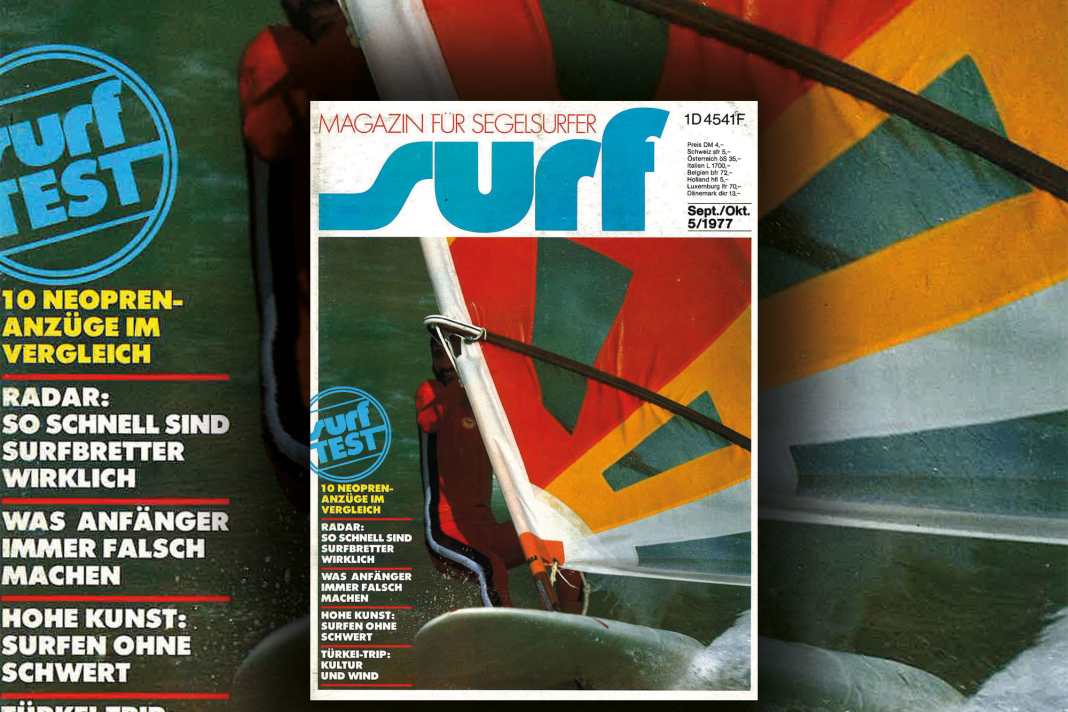





The fifth issue in surf's history marks the birth of the legendary sticker: the cover contains a sticker in the original design, and on the following page it is placed - as an example - on a woman's backside. Over the years, there have been two updates to the stylised windsurfer, most recently in 1992. more than 2 million surf stickers are said to have been put into circulation!
You can click through the entire magazine in the gallery above!
Professional or amateur?
Will the best windsurfers soon be professionals? surf author Jochen Halbe writes in his commentary about the "temptations of manufacturers" who want to set up (and pay for) teams, the attempt to create a European Cup with prize money and the abandonment of amateur status. Above all, the manufacturers hope for a great advertising effect if the best riders surf their own products to good placings. Such commercialisation was viewed with scepticism in the club, association and bureaucracy-loving early days, but a few years later the manufacturers themselves launched the original form of today's World Cup - which has remained at the top to this day thanks to stars and action.
Robby Waalkes or Otto Naish?
Windsurfing is all the rage, even Otto Waalkes wants to get on a board. He summarised his surfing course on Sylt for surf. He reports how he "whizzes over the surface of the water at breakneck speed (120 to 140 km/h), surrounded by spray" and describes the sports equipment ("a board with a colourful cloth on top. Around this cloth is a retaining ring, the so-called jibe. It gets its name from the fact that you can easily twist your neck when jumping from windward to leeward.") and gives tips on riding technique. "Don't forget to pull up the sail when pushing your knees and then keep your upper body leaning slightly forwards in a strong windward position on a half-wind course," advises the East Frisian comedian. Perhaps the resemblance to Robby Naish at the time is no coincidence after all?
For experts: surfing without a daggerboard
In 1977, the crown jewel of riding technique was surfing without a daggerboard. On a space sheet or downwind course, the centreboard mutates into a stubborn opponent for the pilot because the board constantly tends to capsize at higher speeds. The solution: simply pull out the daggerboard. American regatta racers discovered this "trick": "The US boys had the daggerboard hanging casually over their arm, while the Europeans could only save themselves from capsize to capsize". Folding daggerboards had not yet been invented at the time, nor had sealing lips: "A high fountain of water sprays out of the centreboard box - a wonderful feeling, the best thing about surfing!" enthuses the author.
And what else?
- Pearls of advertising I: "In the land of the blind, the one-eyed man is king! Who is this one-eyed man? Jack O'Neill!" The cult brand advertises with the now deceased, iconic founder in a slightly macabre way. What exactly is meant by "wet beaver", however, remains unclear.
- Barter goods: On Lake Chiemsee, a sailor wants to swap his ten-metre yacht for two Ten Cate boards. Several interested parties have reportedly already got in touch.
- Windsurfing enjoys "the sympathy of all those involved" in the Federal Ministry of Transport. For this reason, an impending regulation was revised once again and differentiated from waterskiing. This did not even require the "demonstration ride" offered.
- Advertising pearls II: "If even the hardest drug is too soft for you" - at "Surf Sailer", they have obviously been sitting too close to the resin pots when designing the full-bleed advert page. On DIN A4, the staff is presented, from the warehouse manager to the factory security, as well as the team riders and the test judgements of the trade press. At the bottom, there are accessories such as the harness and a jacket ("The status symbol: the hot jacket for the crisp guy").
- "The surf cart is on the rise", "Harness boom continues" - lots of inventiveness and innovation everywhere!
- surf uses the radar gun to measure how fast windsurfers really are. At a wind force of six, they reach 28 km/h - less than a sailing dinghy. "Sailboards are not dangerously fast speedsters that make our waters unsafe!"
- Mast to windward! What surf students think about the key moment, what surf instructors say about it
- "Surfing and windsurfing, surfing and board sailing, one born from the other but suddenly far apart, are now slowly starting to merge again." - surf shows some good surf spots to go with it.
- Blurriness has never been more appreciated than in the surf poster. If there weren't a lot of spray and water droplets in the centre of the picture, it would have a gynaecological touch.
You can click through the entire magazine in the gallery above!

